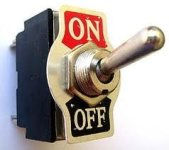Garrick_s
100 W
Hello all,
I want to get a better "on/off" switch than what was supplied in the kit.
I see some at radio shack and such, but I'm not sure what requirements need to be met with what ever switch I choose
Right now the bike is 48V / 10ah.
Considering bumping up to 72 volt soon.
so I want the switch to be able to handle the high voltage too.
Basic two pull - on/off.
Right now its a typical toggle

An illuminated rocker would be cool but not mandatory.
SO - what are the basics I need to look for in a switch?
AMP requirements? VOLT requirements?
Thanks for helping a rookie.
I want to get a better "on/off" switch than what was supplied in the kit.
I see some at radio shack and such, but I'm not sure what requirements need to be met with what ever switch I choose
Right now the bike is 48V / 10ah.
Considering bumping up to 72 volt soon.
so I want the switch to be able to handle the high voltage too.
Basic two pull - on/off.
Right now its a typical toggle

An illuminated rocker would be cool but not mandatory.
SO - what are the basics I need to look for in a switch?
AMP requirements? VOLT requirements?
Thanks for helping a rookie.

